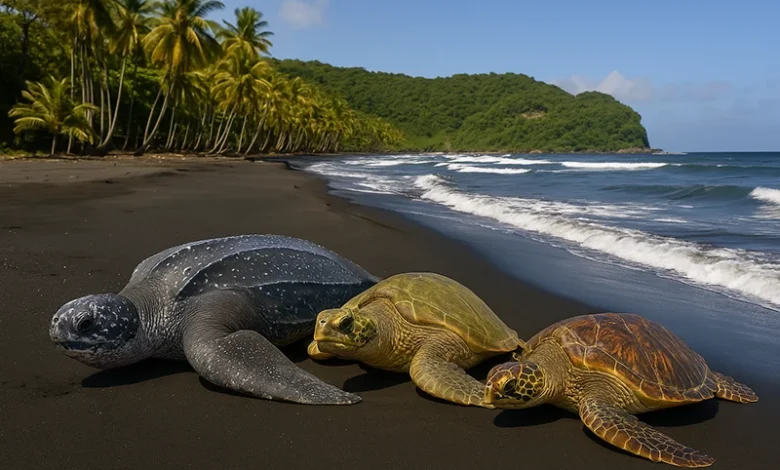Endangered Sea Turtles in Dominica

Endangered Sea Turtles in Dominica are drawn to the island’s unspoiled beaches, where species like the Leatherback Turtle, Green Turtle, and Hawksbill Turtle return to nest each year. These ancient mariners, present in Earth’s oceans for millions of years, now face growing threats that endanger their continued survival.
Endangered Sea Turtle Species in Dominica
Dominica’s coastline supports nesting populations of three endangered sea turtle species. Each species faces unique threats, behaviors, and conservation needs vital to marine biodiversity.
Leatherback Turtles (Dermochelys coriacea)
As the largest of all sea turtle species, Leatherbacks can exceed six feet in length and weigh over 1,000 pounds. They are distinguished by their unique, leathery shells. In Dominica, Leatherbacks typically nest between March and August, with peak activity from April to July. Despite their grandeur, they are critically endangered due to factors such as bycatch in fisheries, marine pollution, and loss of nesting habitats.
Green Turtles (Chelonia mydas)
Named for the greenish hue of their body fat, Green Turtles are medium to large-sized, averaging 3 to 4 feet in length. They frequent Dominica’s coastal waters and nest primarily from June to September. Threats to their population include hunting, habitat degradation, and incidental capture in fishing gear.
Hawksbill Turtles (Eretmochelys imbricata)
Recognized for their beautiful, patterned shells, Hawksbill Turtles are critically endangered. They nest on Dominica’s beaches between May and October. Their decline is largely attributed to the illegal trade of their shells, loss of coral reef habitats, and entanglement in fishing gear.
Conservation Efforts in Dominica
To combat the decline of these majestic creatures, Dominica has implemented several conservation initiatives:
- Legal Protection: Sea turtles in Dominica are safeguarded by law, prohibiting their capture and the disturbance of nesting sites. The Dominica Sea Turtle Conservation Organization Inc. (DomSeTCO) plays a pivotal role in monitoring and protecting these animals, ensuring compliance with conservation regulations.
- Community-Based Programs: Eco-friendly resorts like Rosalie Bay Resort have established sea turtle conservation programs. Guests can participate in guided turtle watching experiences, fostering awareness and support for conservation efforts. These programs have been instrumental in reversing the decline of Leatherback, Green, and Hawksbill turtle populations in the area.
- Beach Monitoring and Protection: Organizations such as Oceans Forward support patrollers who safeguard nesting beaches, relocate nests from hazardous areas, and advocate for the establishment of protected zones to facilitate population recovery.
Challenges and Threats
Despite these efforts, sea turtles in Dominica continue to face significant challenges:
- Climate Change: Rising temperatures can skew the sex ratios of hatchlings, while sea-level rise threatens nesting beaches.
- Artificial Lighting: Lights from coastal developments can disorient hatchlings, leading them away from the sea and increasing mortality rates.
- Pollution and Marine Debris: Ingestion of plastics and entanglement in debris pose lethal risks to sea turtles.
- Illegal Harvesting: Despite legal protections, poaching of turtles and their eggs persists in some areas.
How You Can Help
Visitors and locals alike can contribute to the preservation of Dominica’s sea turtles:
- Participate in Responsible Turtle Watching: Engage with certified guides and organizations to observe turtles without causing harm or disturbance.
- Support Conservation Initiatives: Contribute to or volunteer with local organizations dedicated to sea turtle protection.
- Reduce Plastic Use: Minimize plastic consumption to decrease ocean pollution, which poses a threat to marine life.
- Advocate for Sustainable Practices: Encourage and support policies and practices that protect marine habitats and reduce human impact on the environment.
By fostering awareness and actively participating in conservation efforts, we can ensure that Dominica’s beaches remain a sanctuary for these remarkable creatures for generations to come.




